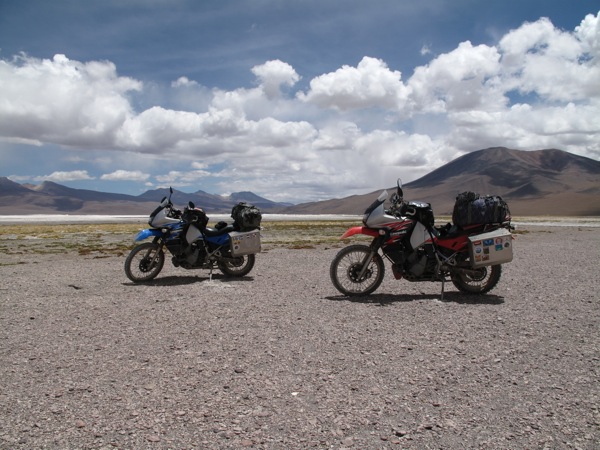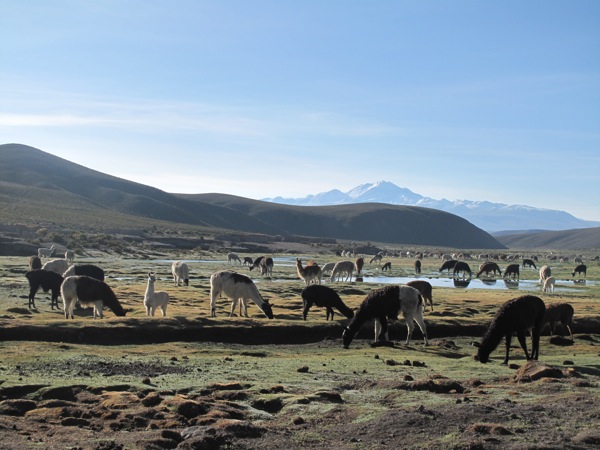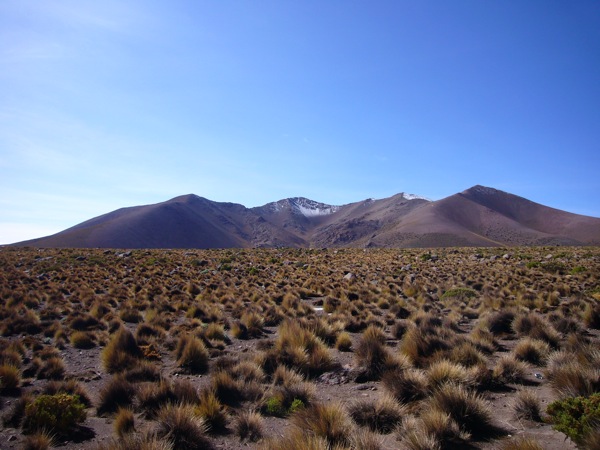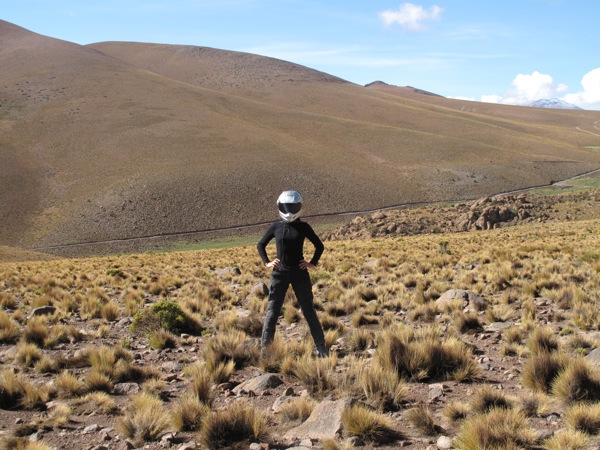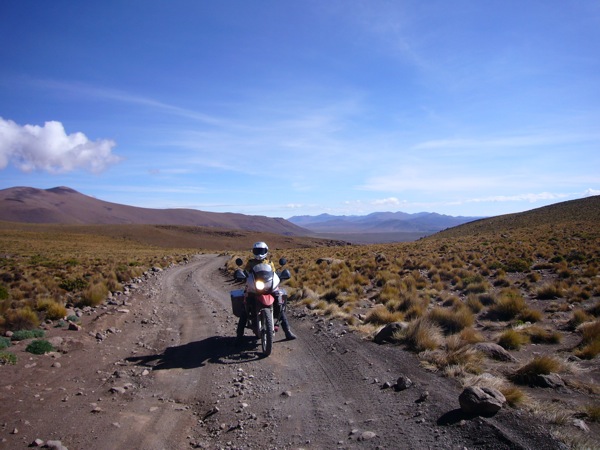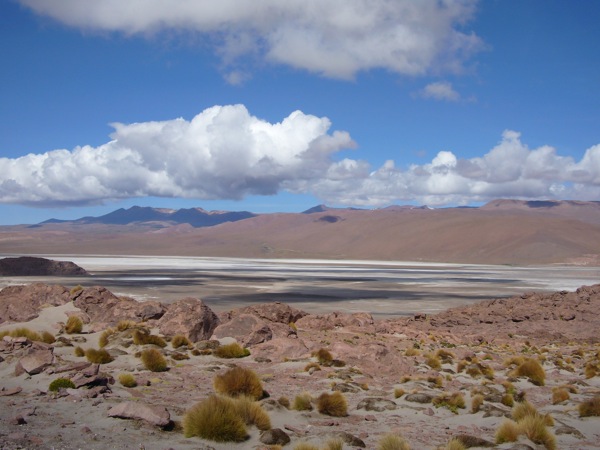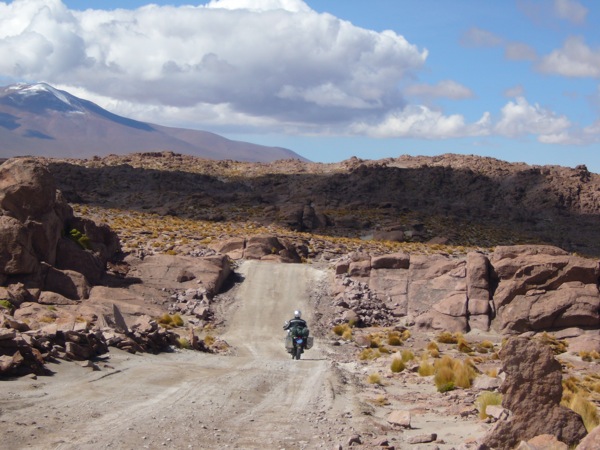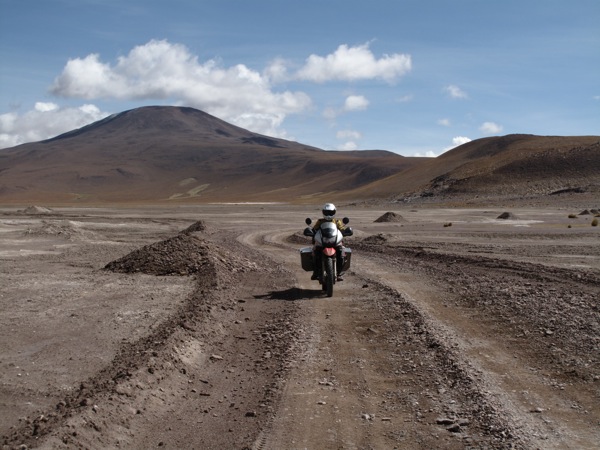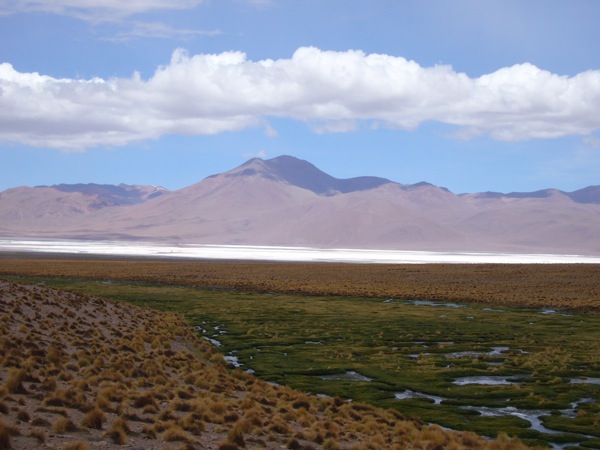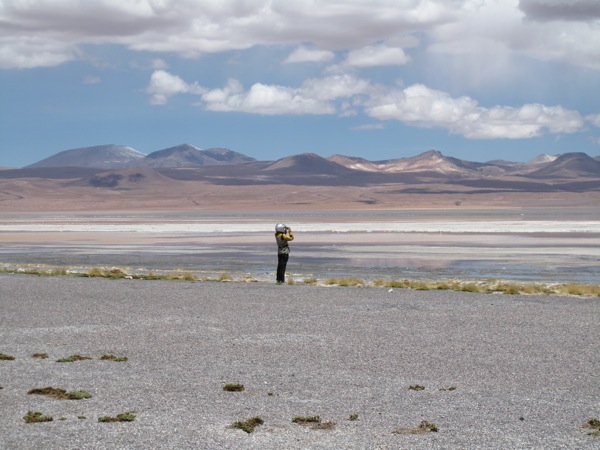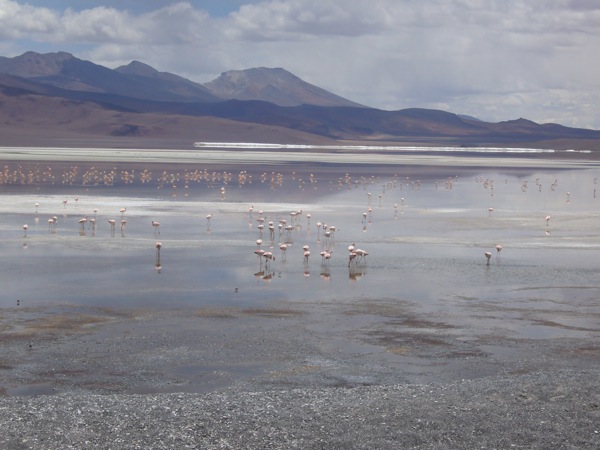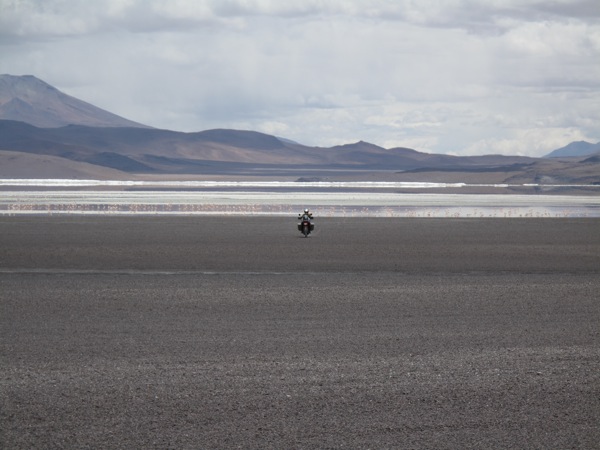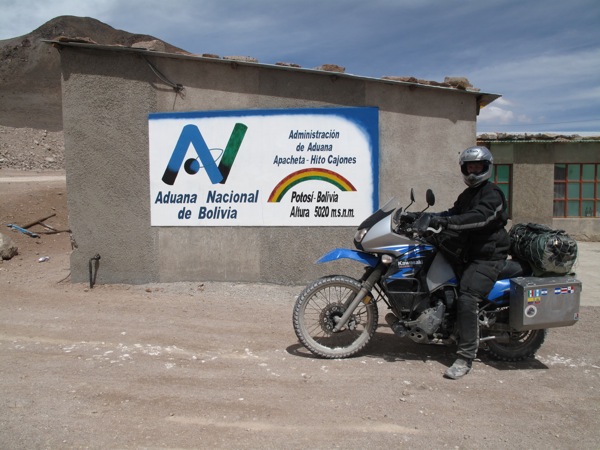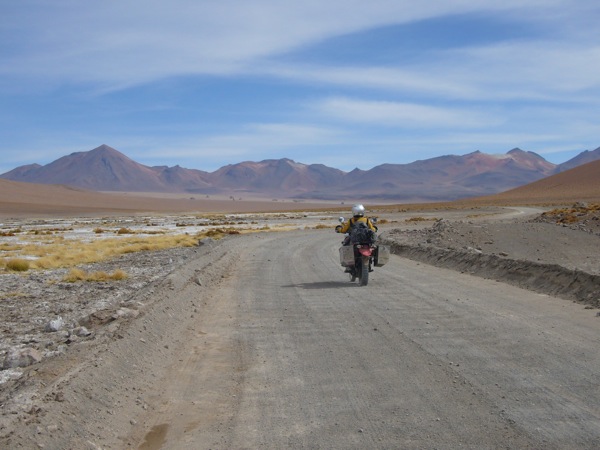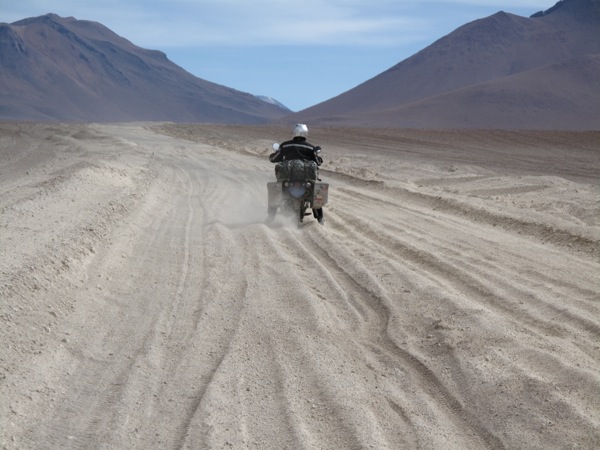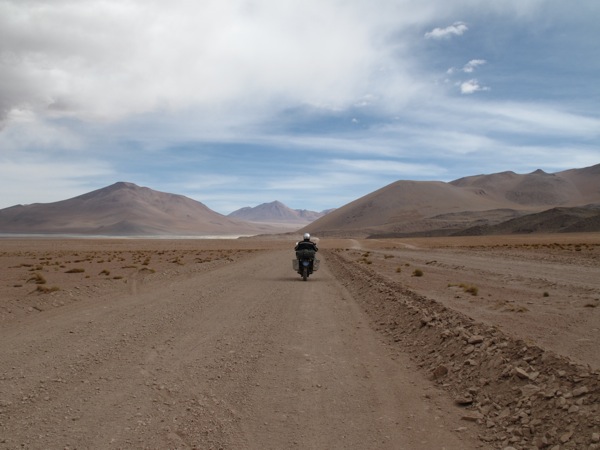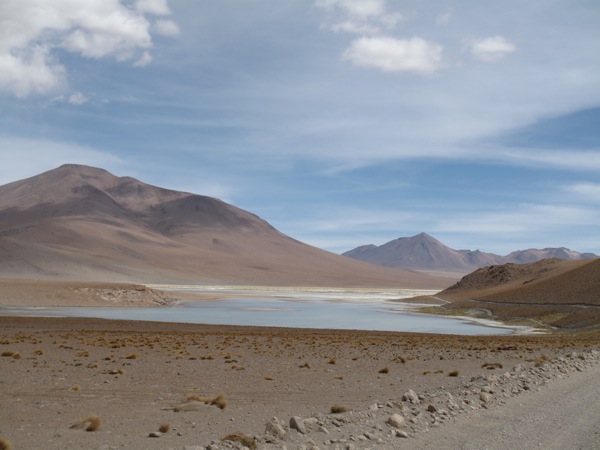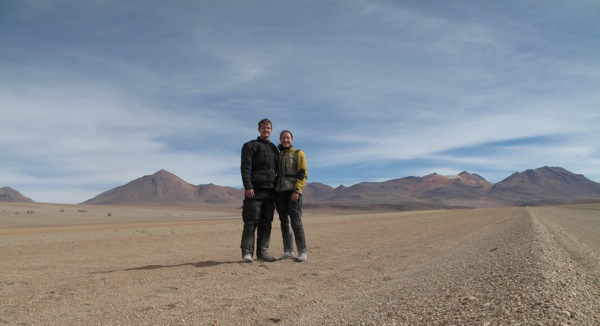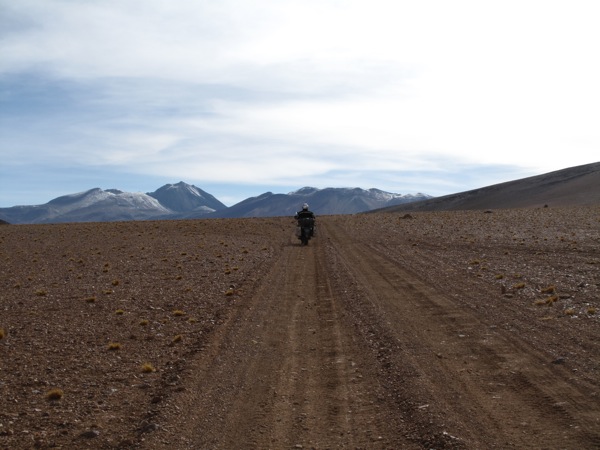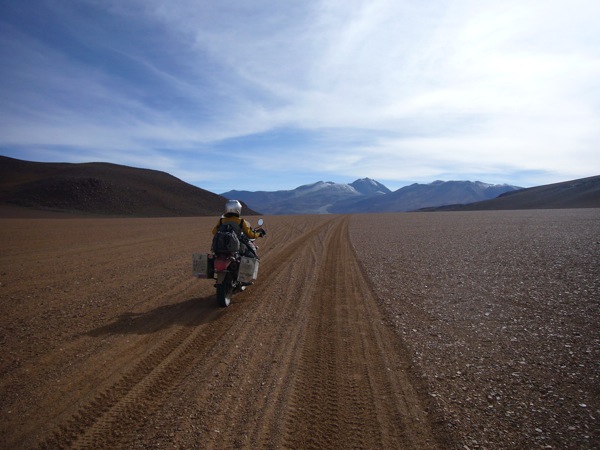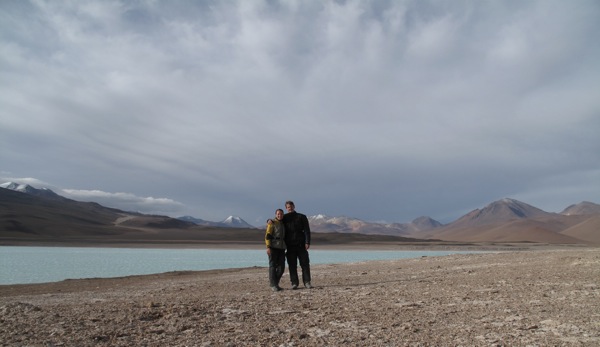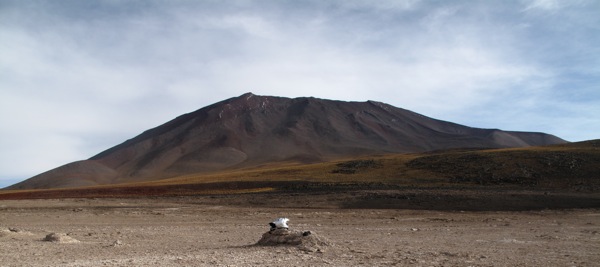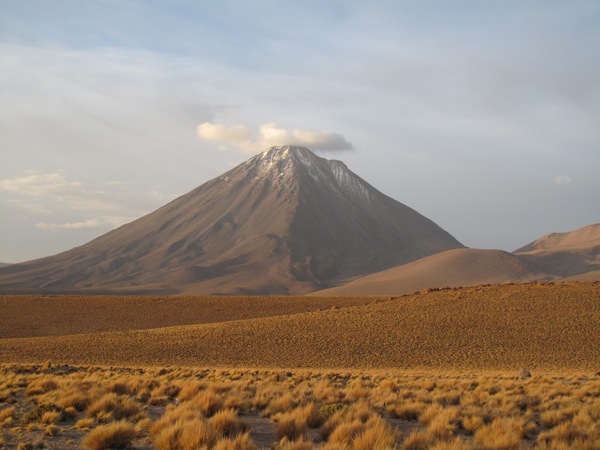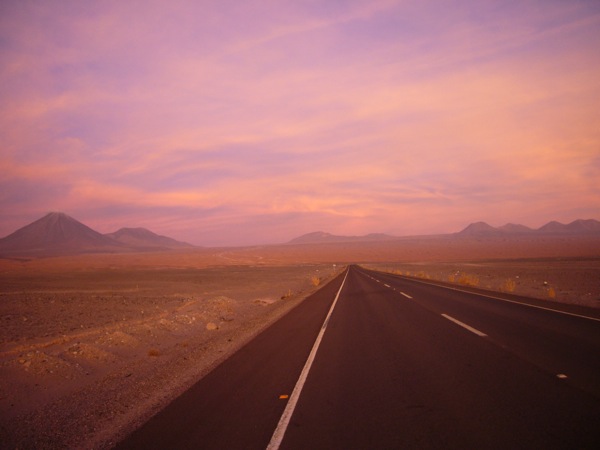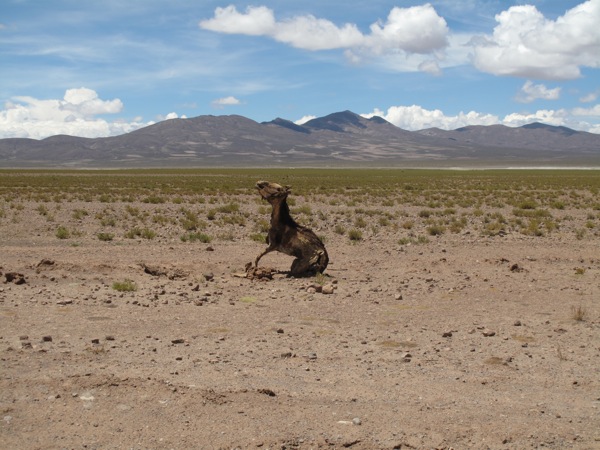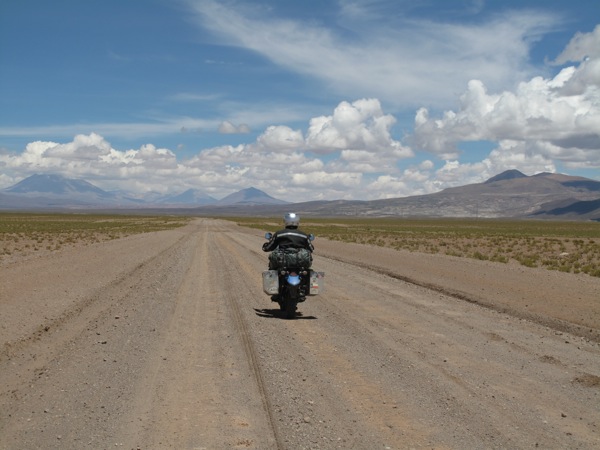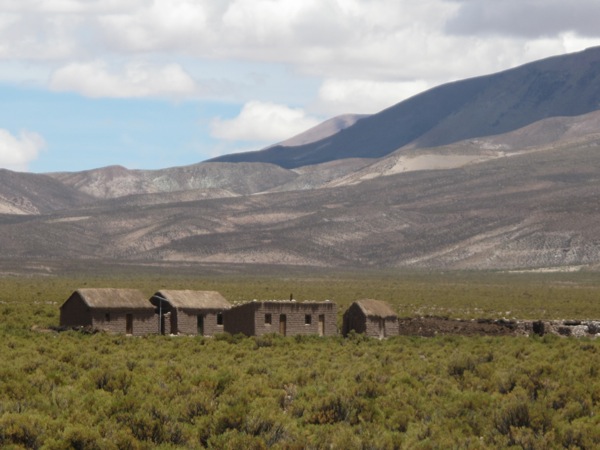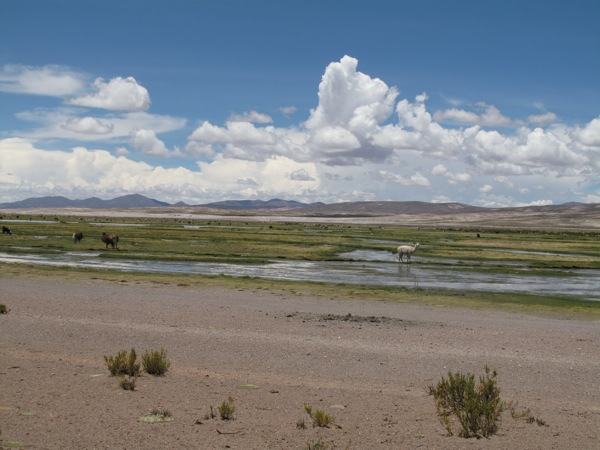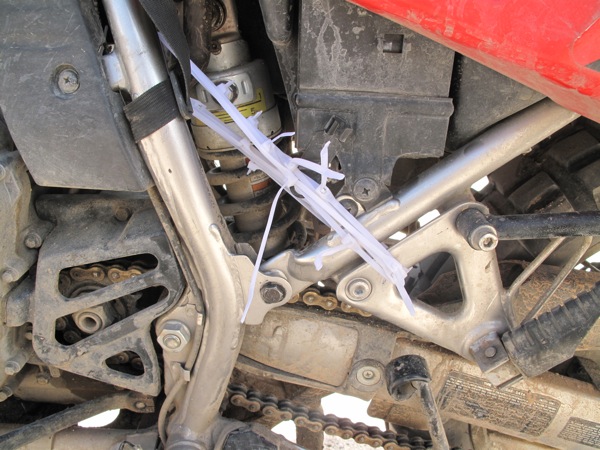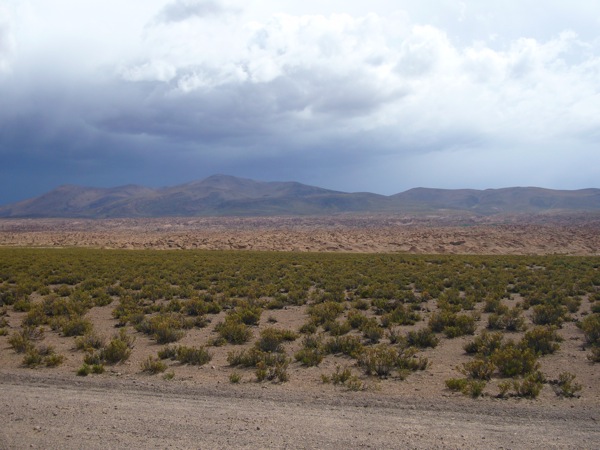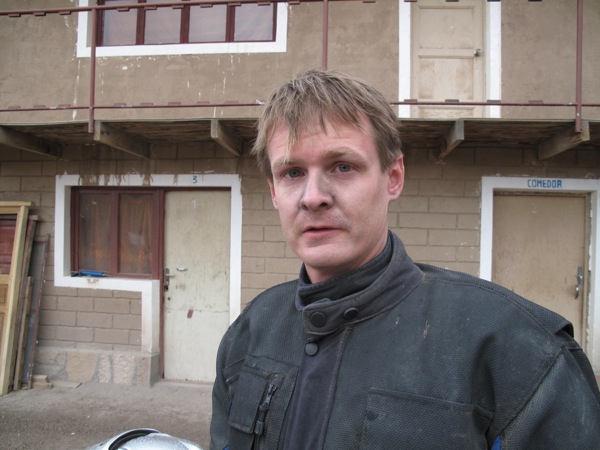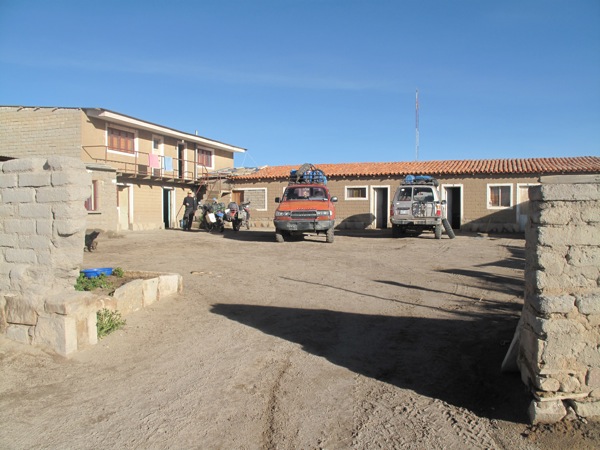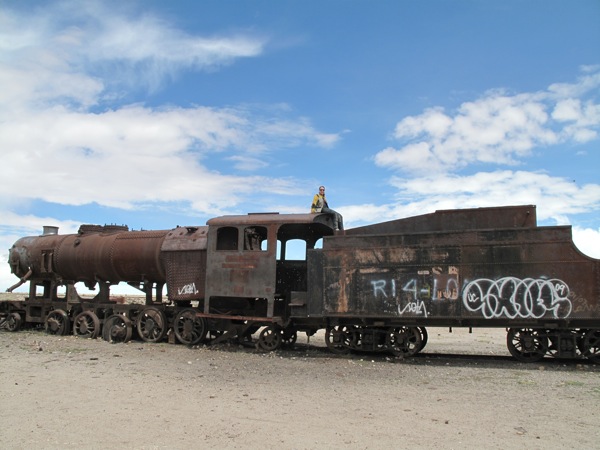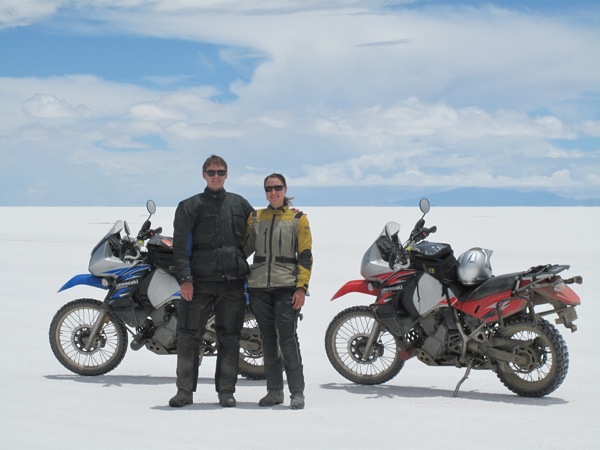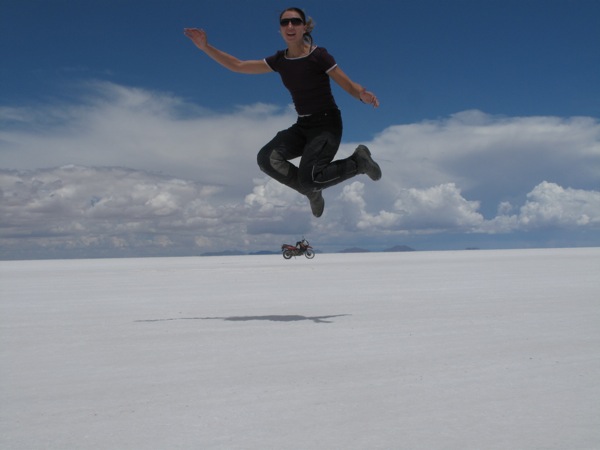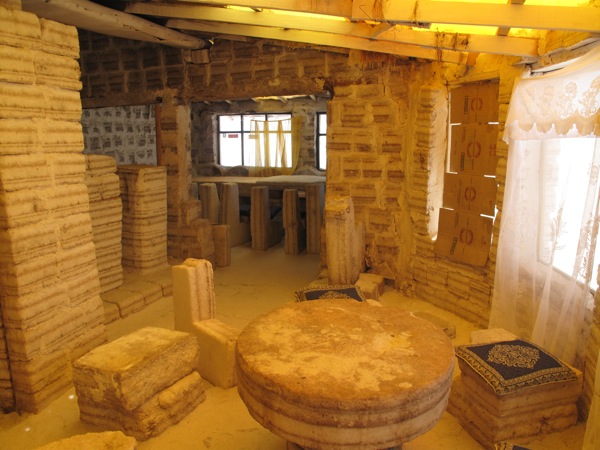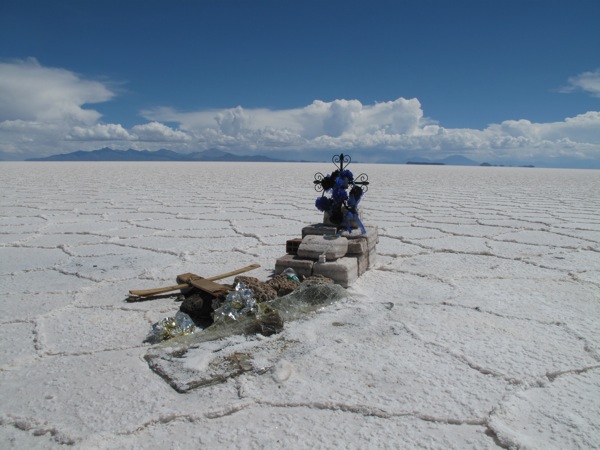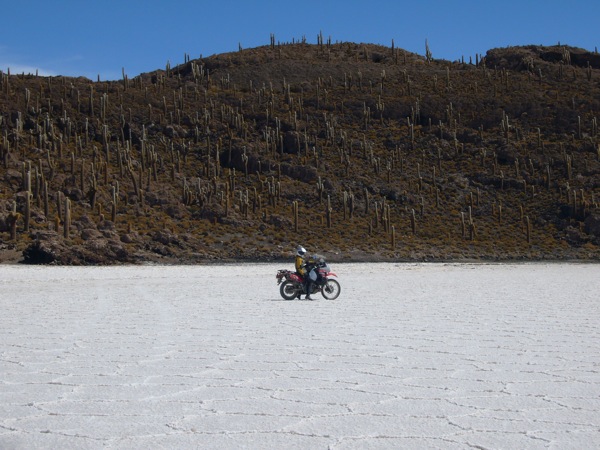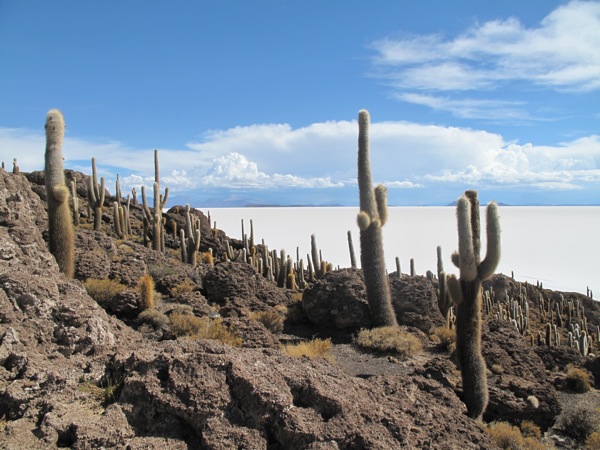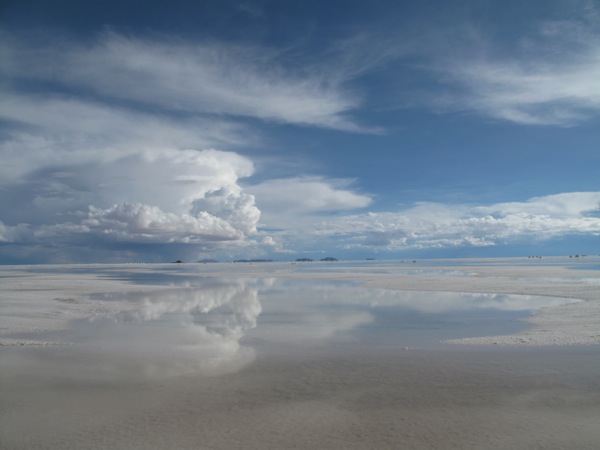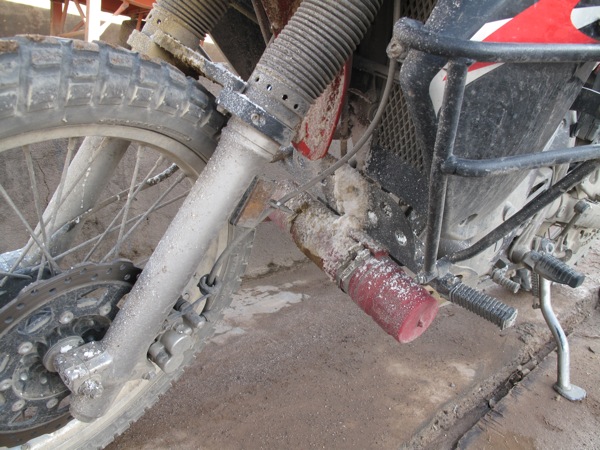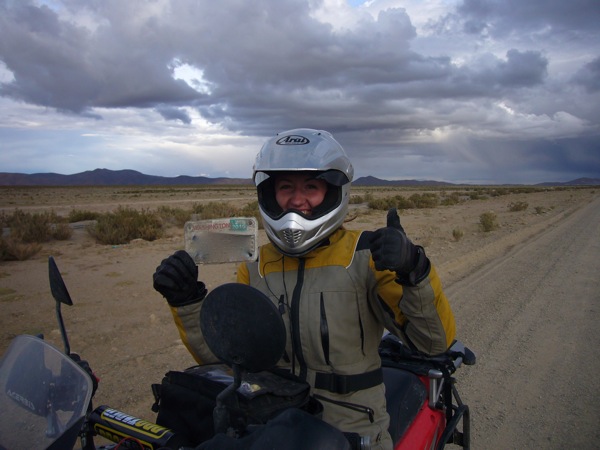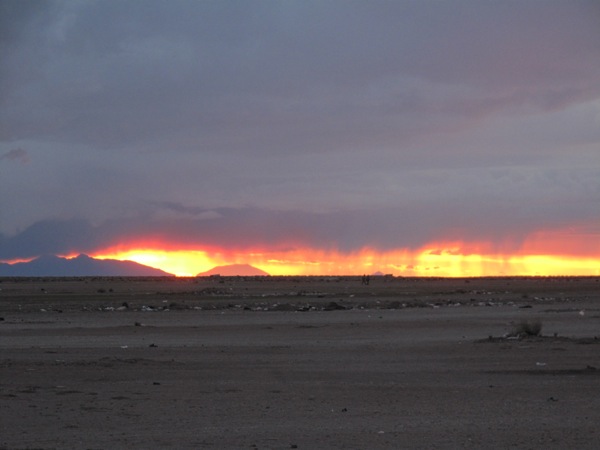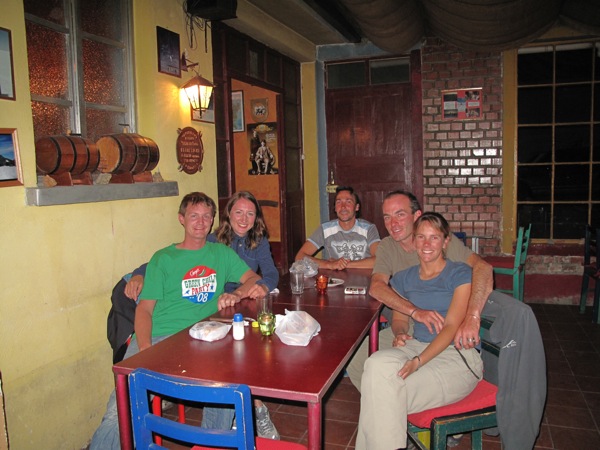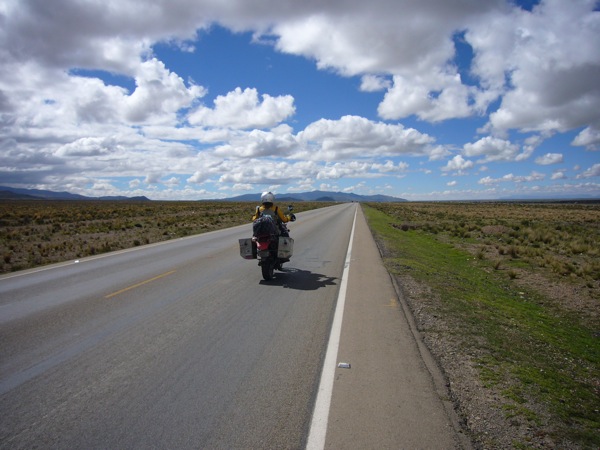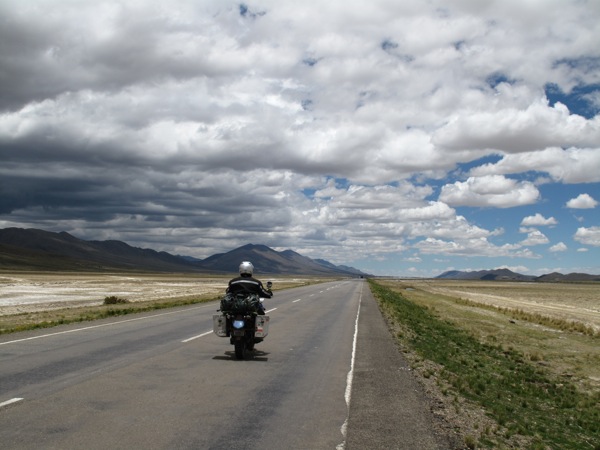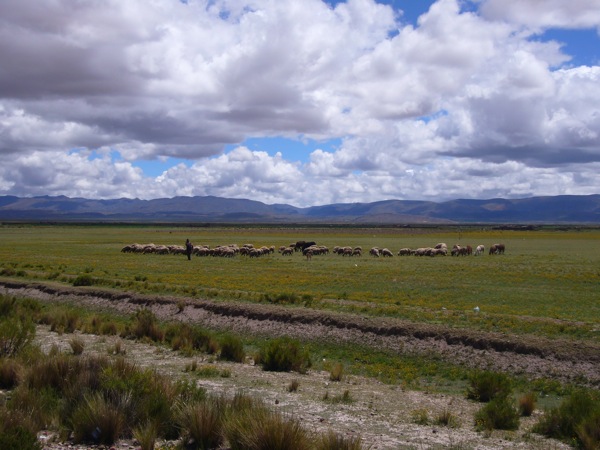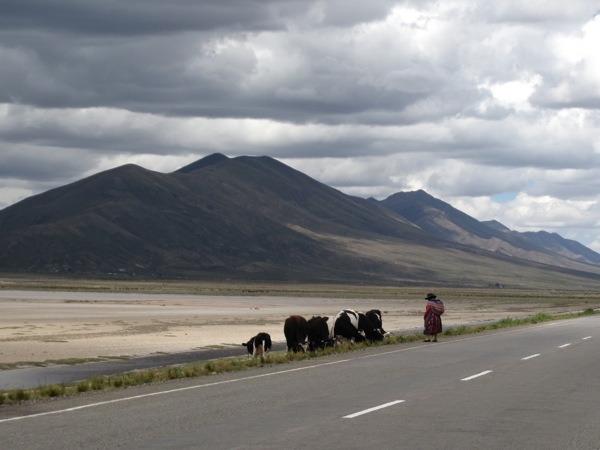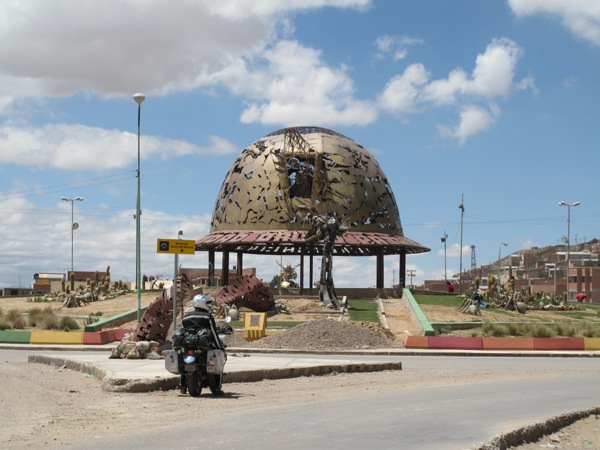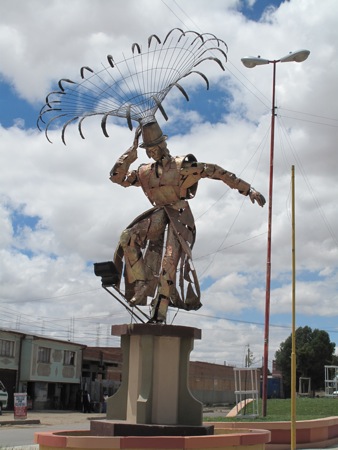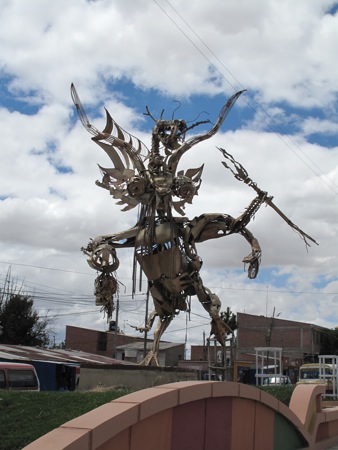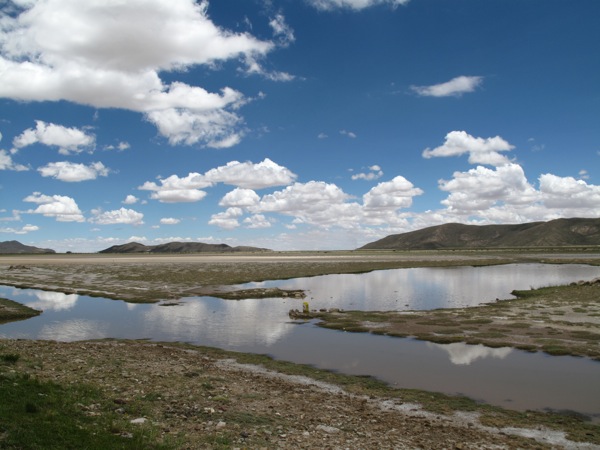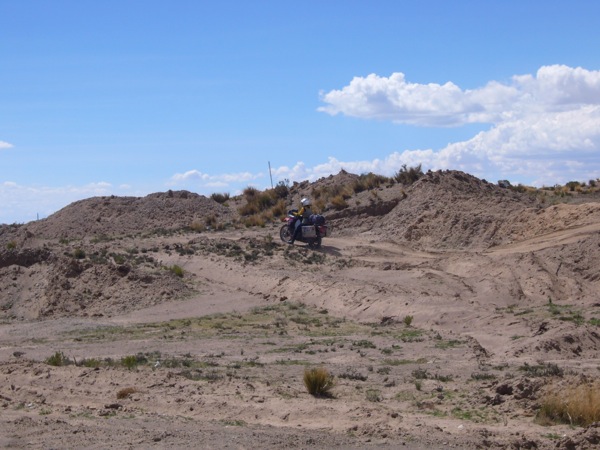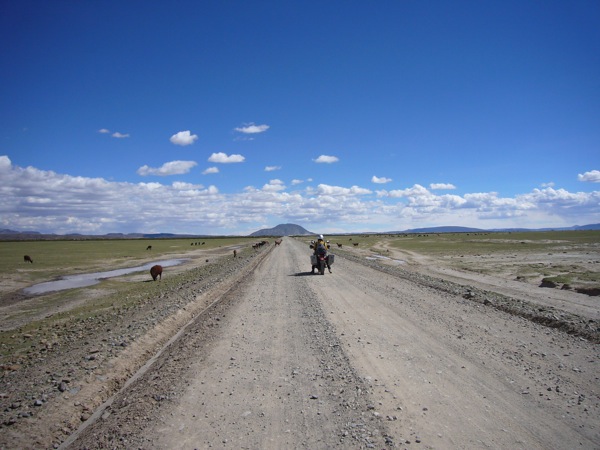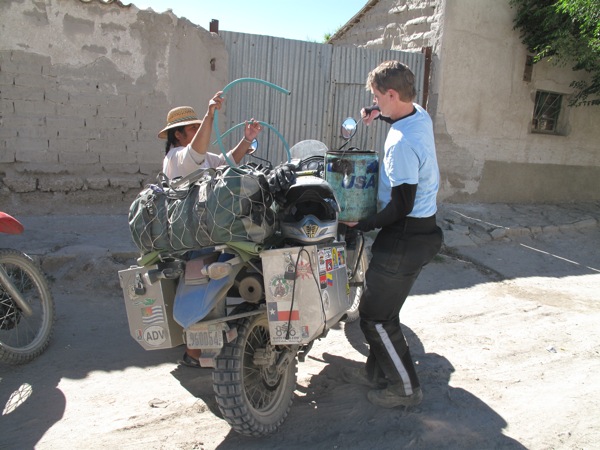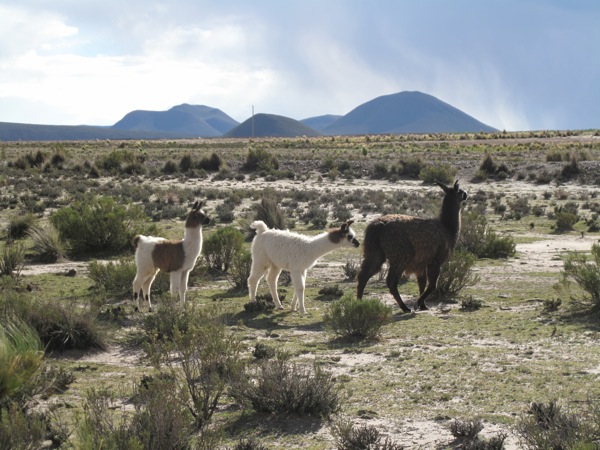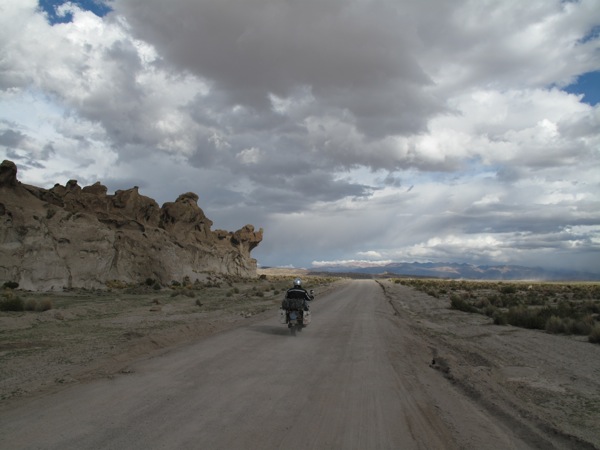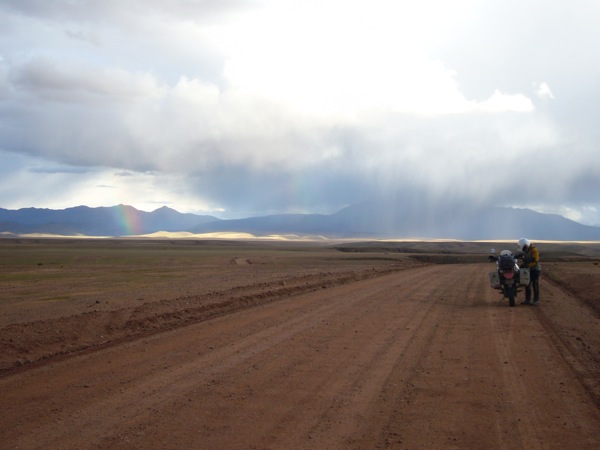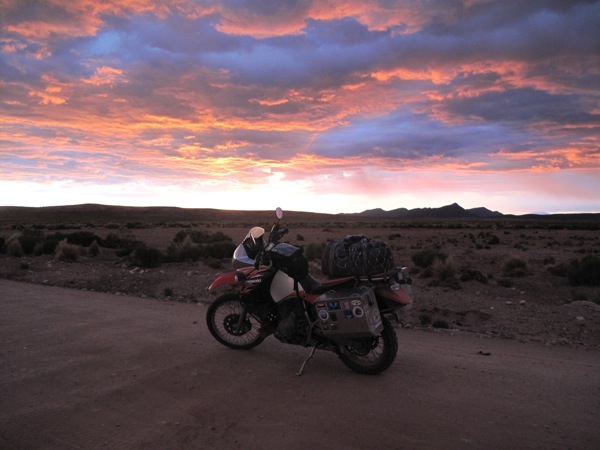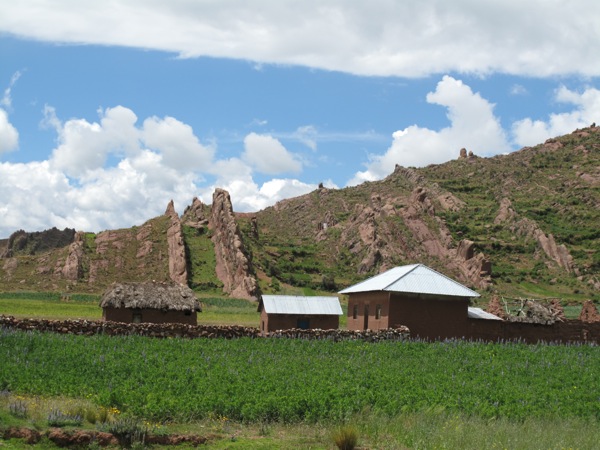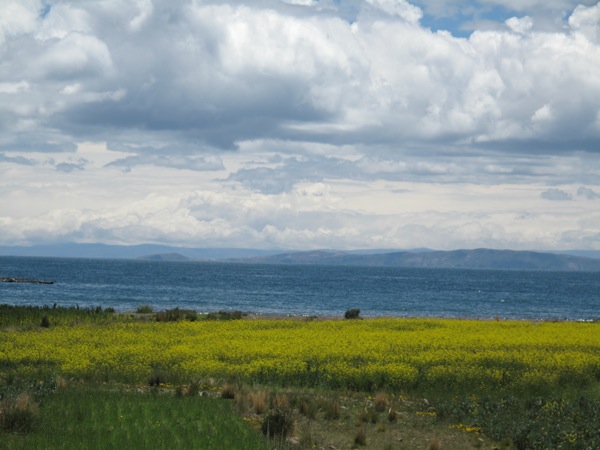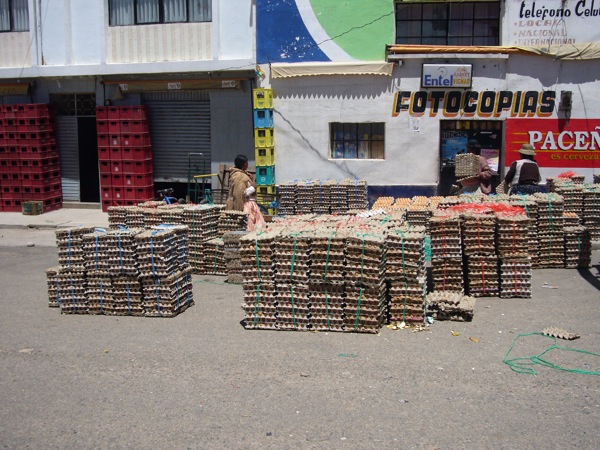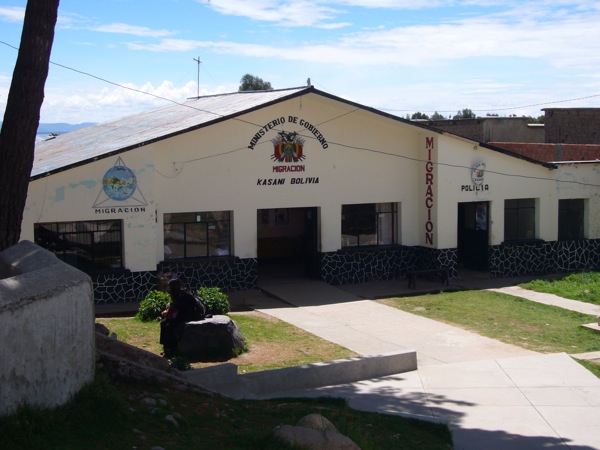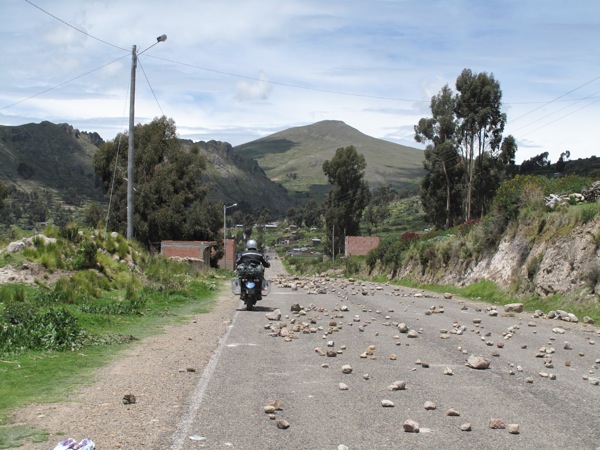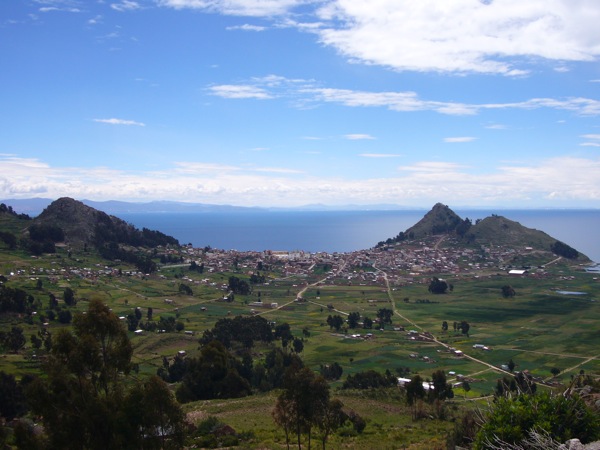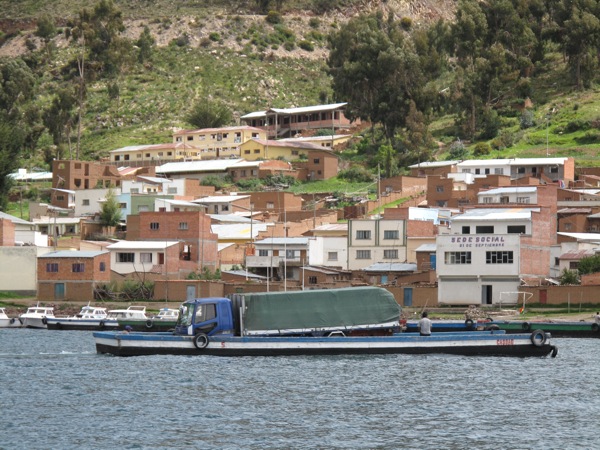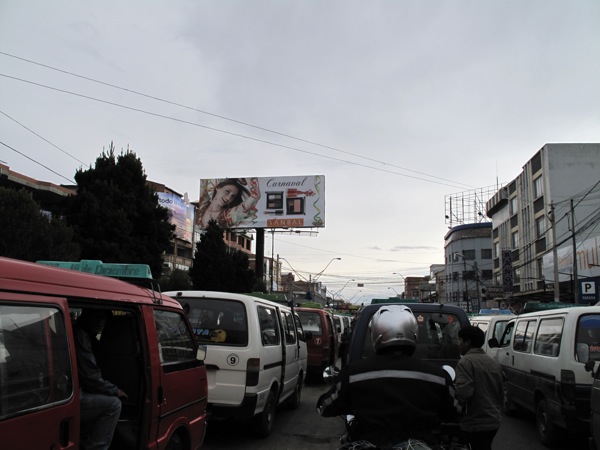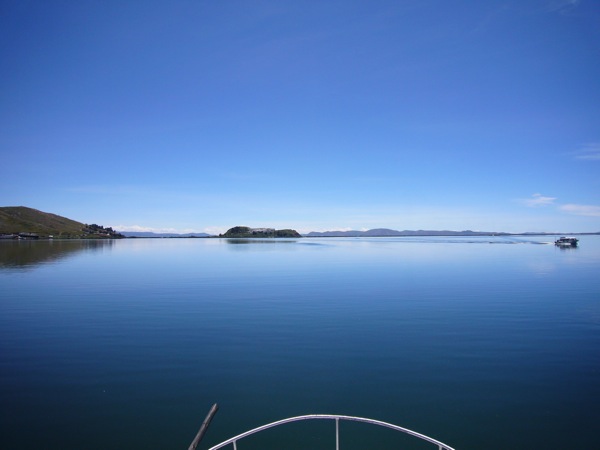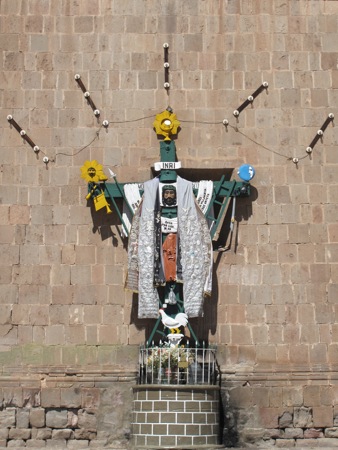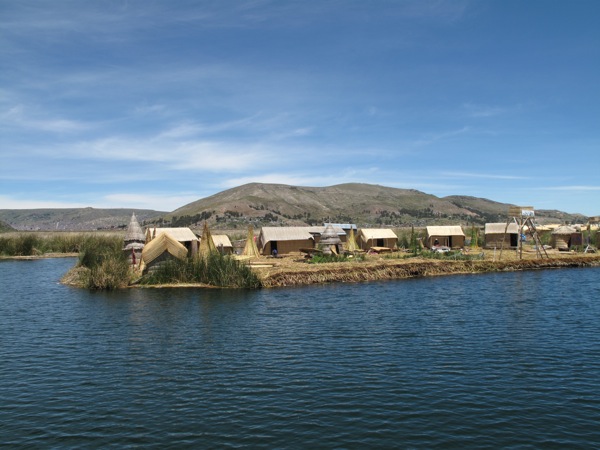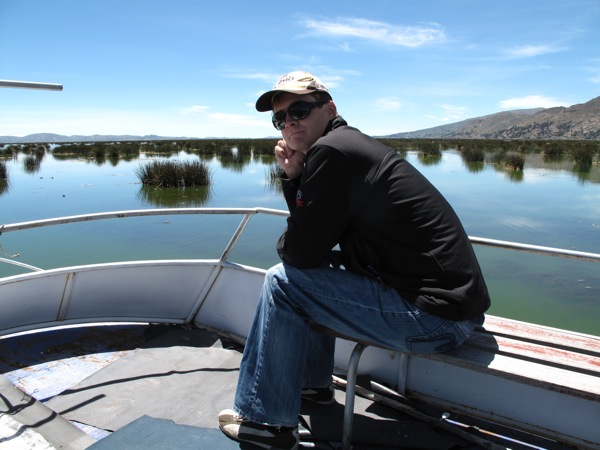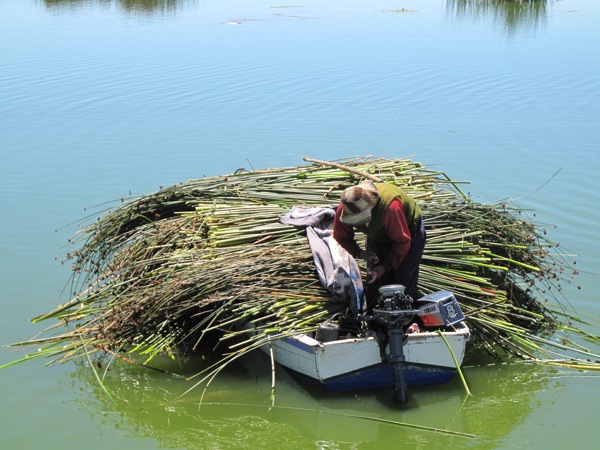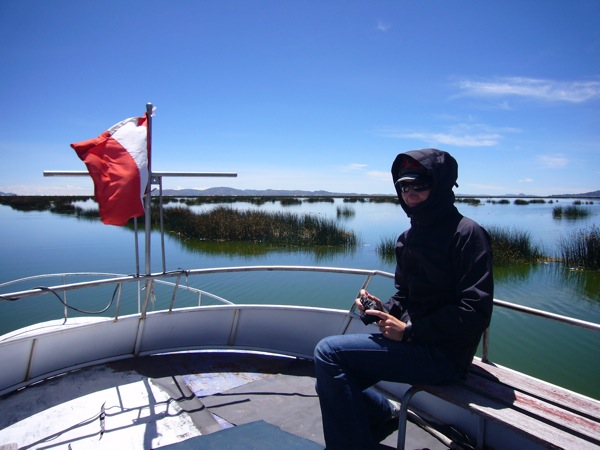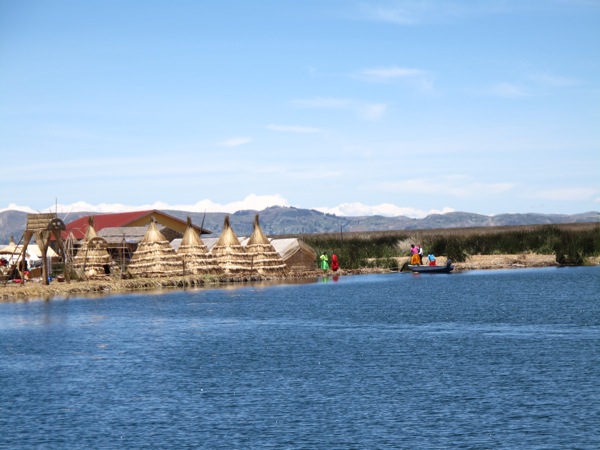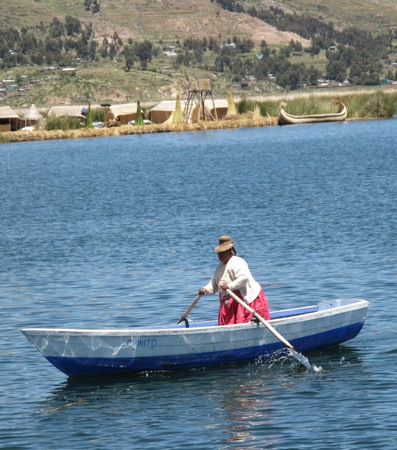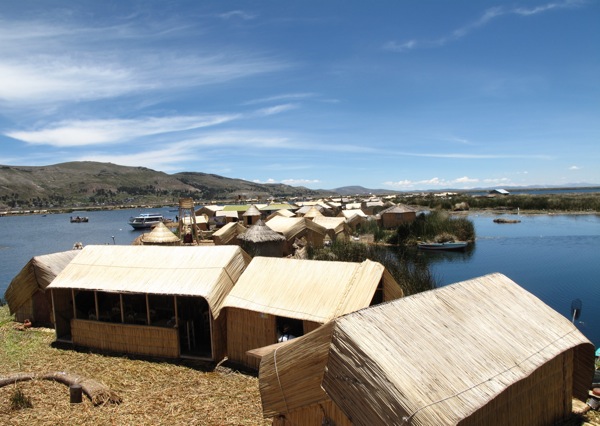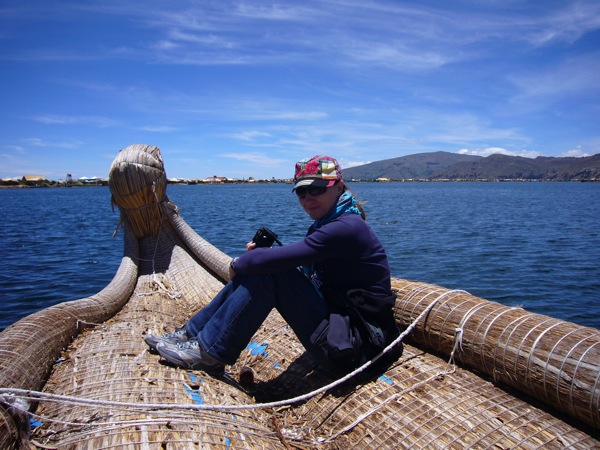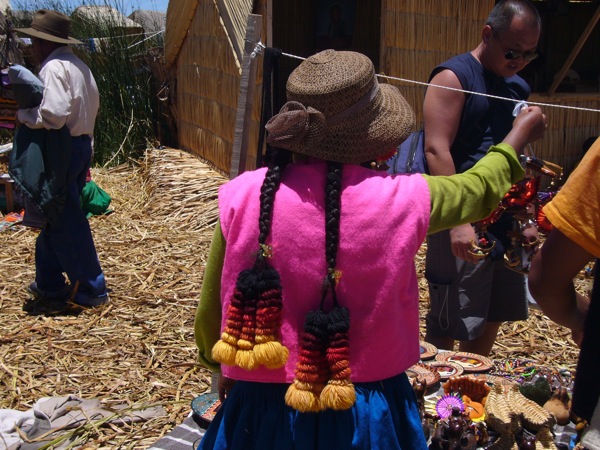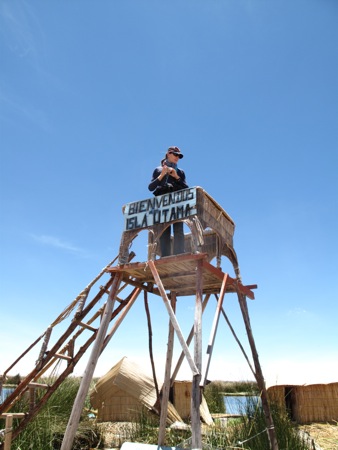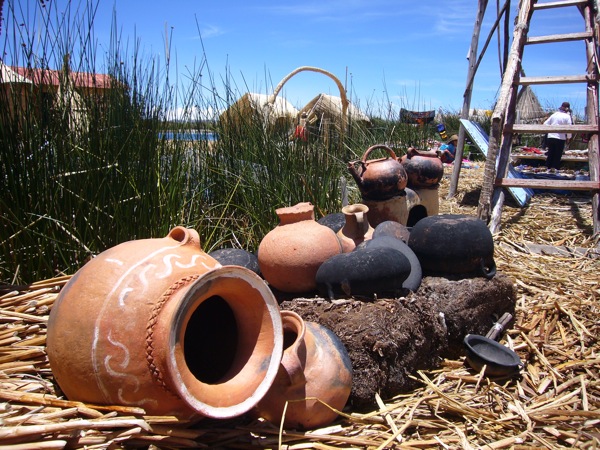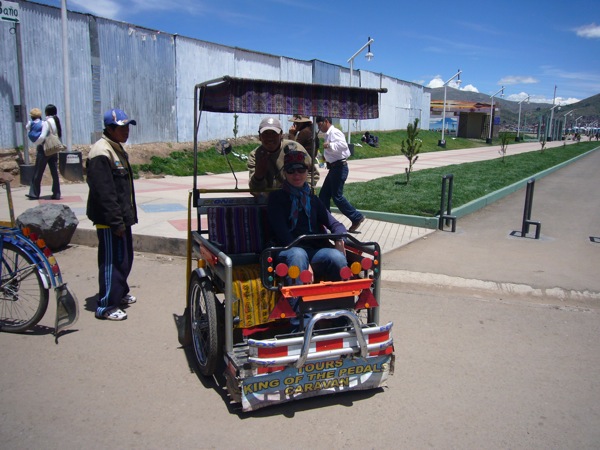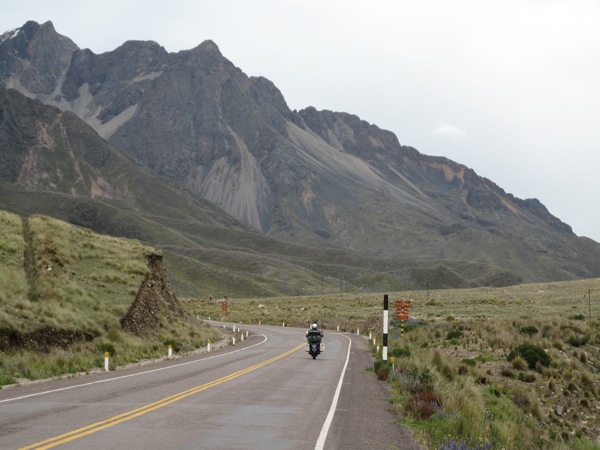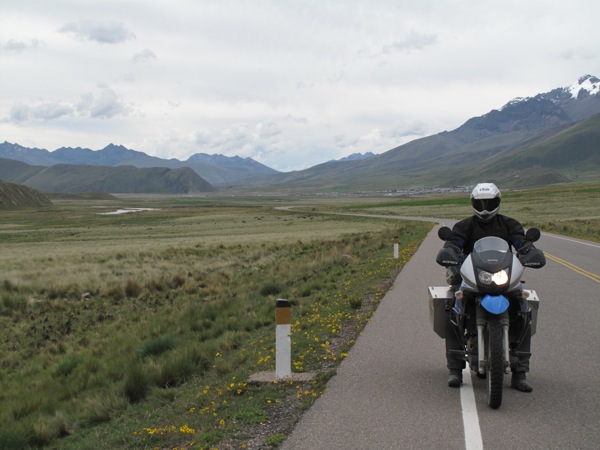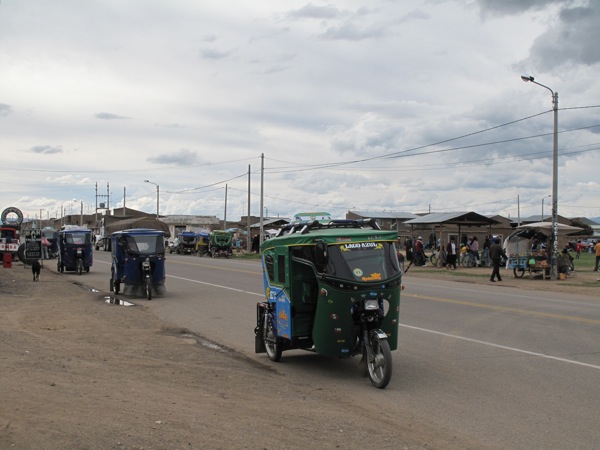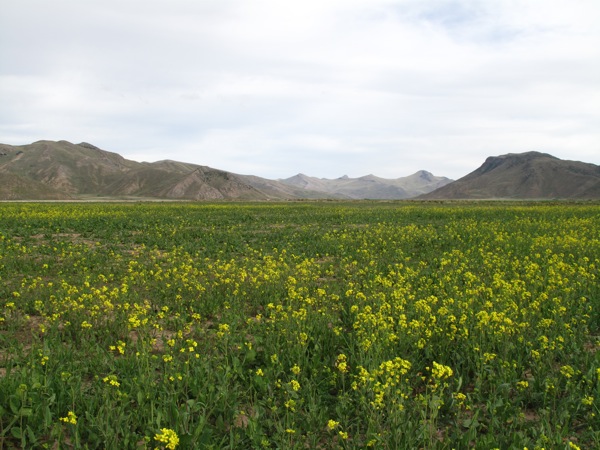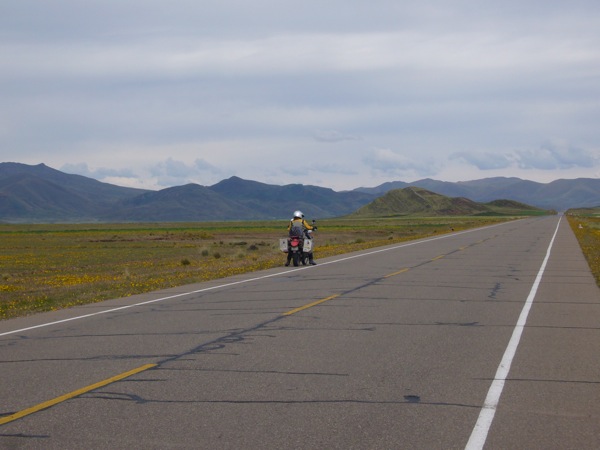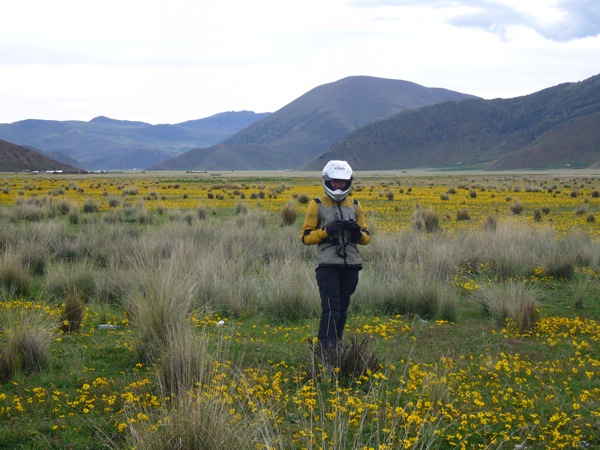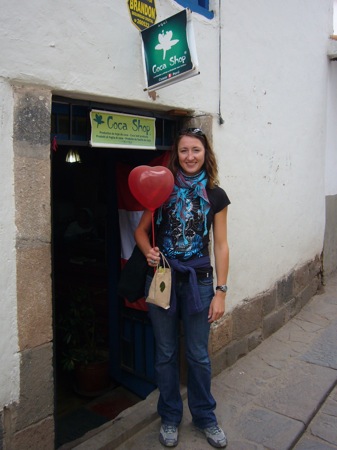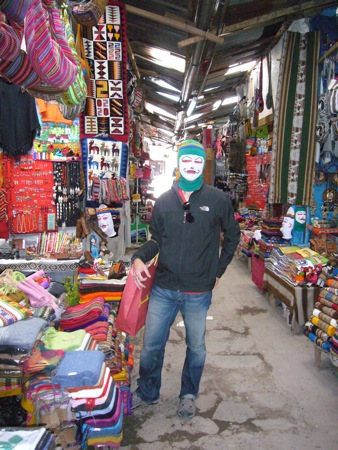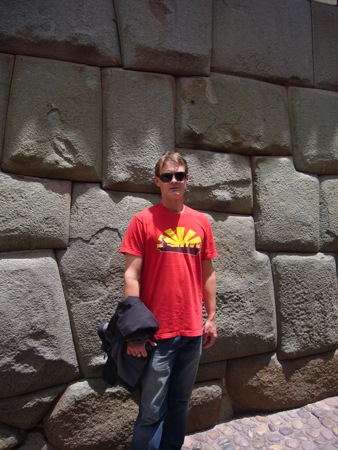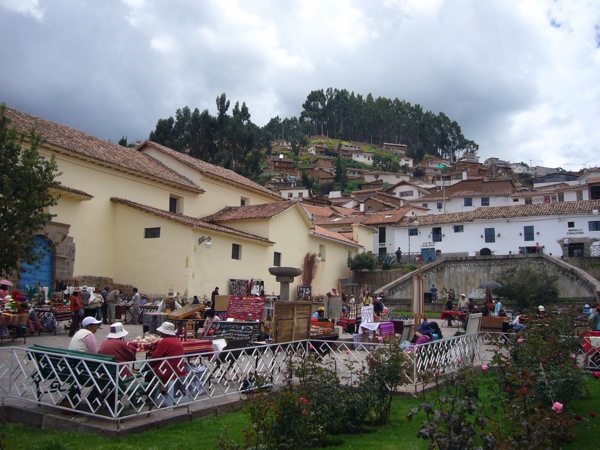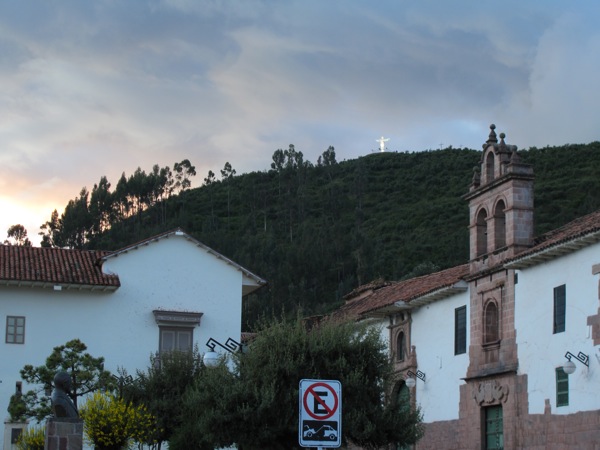San Pedro de Atacama, Chile to San Antonio de Cobres, Argentina
- on 03.05.09
- Argentina, Chile
- 1 Comment
- Digg
- Del.icio.us
Sunday, February 22
There were not enough hours in the night to allow us to rest from the previous days in Bolivia. Checkout was at 10 am and we slept as late as possible and the hour time change made it really 9 am body clock time. We struggled out of bed and went to get breakfast. The hotel cafe was also a bakery, but hotel guests were not worthy of fresh baked goods and we were given old pastries for breakfast.
We were not fans of San Pedro de Atacama. It was a full on gringo tourist town, the kind of place we try to avoid when possible. It was also vastly overpriced, so despite our original plan of staying put for a few days we were on a mission to get out of there as soon as possible. As we were packing the bikes I took stock of the blue bike after yesterday’s crash. The upper right fairing and the upper center fairing were cracked. The corner welds on my right pannier I had redone in Panama were cracked again. It depressed me.
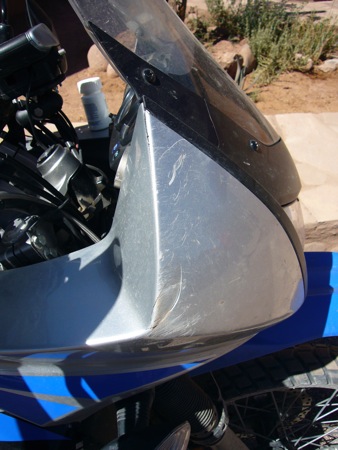
We found an ATM after some misdirection, and headed out to find a gas station. Lauren and Martin had mentioned how surprisingly hard to find it was in this town, so we looked carefully. It was amazingly well hidden in between two streets, behind a wall. There was no sign indicating it was there so I’m not sure how anyone was supposed to find it. Without the help of a local motorcycle we would have been looking for hours. Our desperation to leave was evident when we were chastised for making a pass on a police vehicle that was driving along at 2 km/h.
We had heard great things about the Paso de Sico to Argentina, and it sounded more interesting than grinding through the Atacama Desert of Chile. We went back to the Chilean immigration and checked out of Chile. I think we were officially in the country for 14 hours and doing the entry/exit paperwork was a real waste of time. It was an indicator that we didn’t pick up on of how isolated our chosen border crossing was that we were checking out over 100 km from the border.
The first 70 km or so going south to Socaire was a very pleasant ride on smooth pavement. After Bolivia ee were deeply appreciative of any form of pavement so those were happy kilometers for us. After [Socaire], the pavement ended and we were back on the dirt. The road wasn’t too bad. There was some corrugation and loose gravel, but generally it was far better than the Bolivian roads.
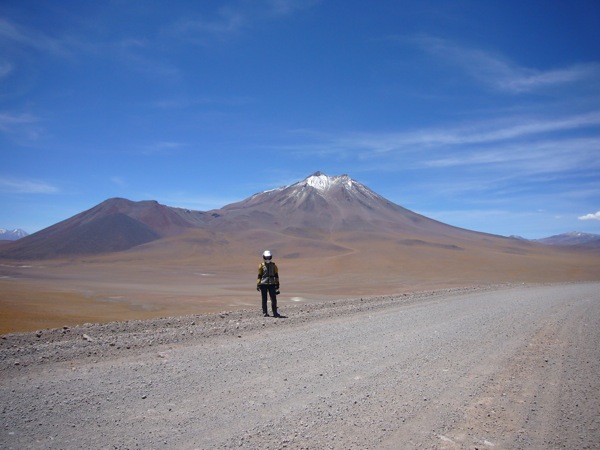
The scenery was similar in some way, wide open desert vistas with smooth mountains and sparse vegetation. We weren’t enthused about being back on dirt the day after we’d gotten out of Bolivia, but we were making good time and the distance to go looked small on the map.

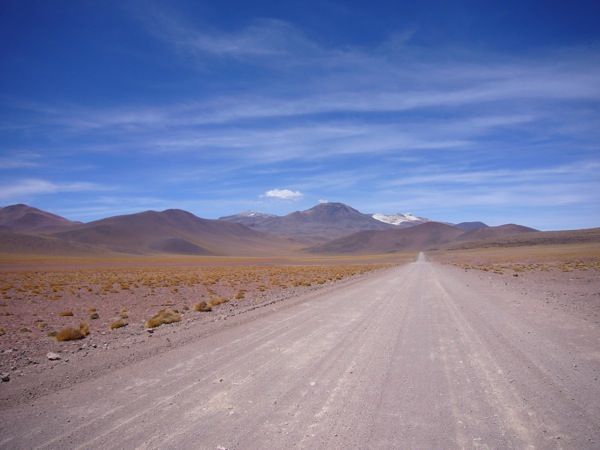
The landscape surprised us with its beauty. The road stretched out for miles ahead of us and each new valley brought new, stunning mountains and open plains. The vegetation was too arid for llamas, but small family groups of vicuñas still roamed the land, scattering when we grew close. The sense of isolation was even stronger than in Bolivia and we didn’t see another vehicle for hours at a time.
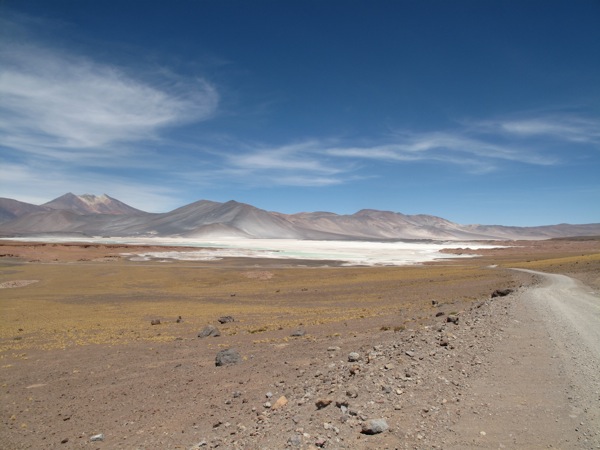
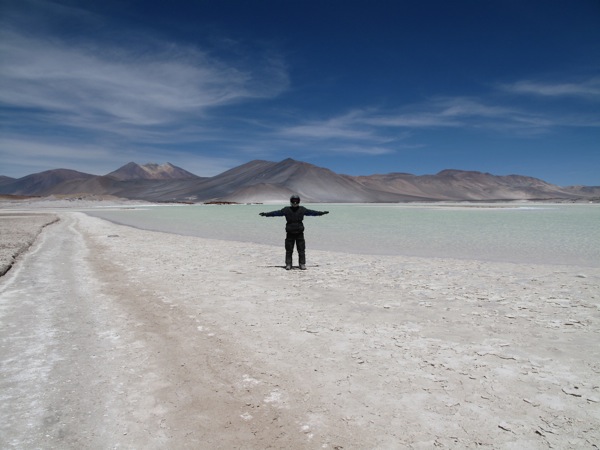
We descended into a salar valley, delighted to discover another blue-green laguna, this one even better than Laguna Verde. We left the road and rode down to the soft salty shore. It reminded us of a tropical beach, except we were surrounded by gray mountains and volcanic cones.

We lingered as long as we dared, and then rode back to the dirt track and moved on. The silence and isolation was profoundly peaceful and the sun shining brightly down and leaving no shadows in the landscape. We rode through this landscape for the entire afternoon, finally reaching a Chilean border outpost. The road had a few sandy patches, but overall wasn’t too bad. The official there crushed our spirits by telling us the roads were worse on the Argentinean side.
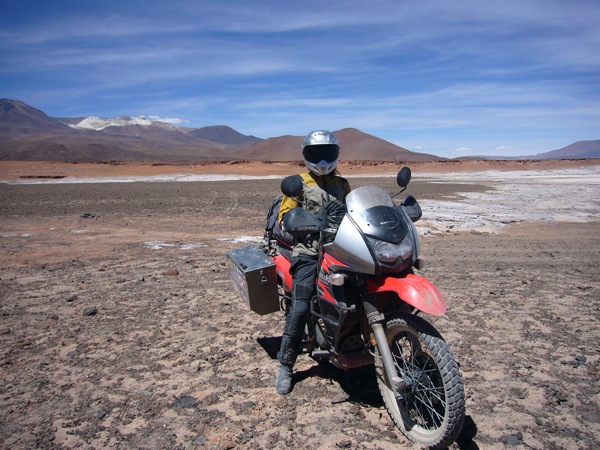
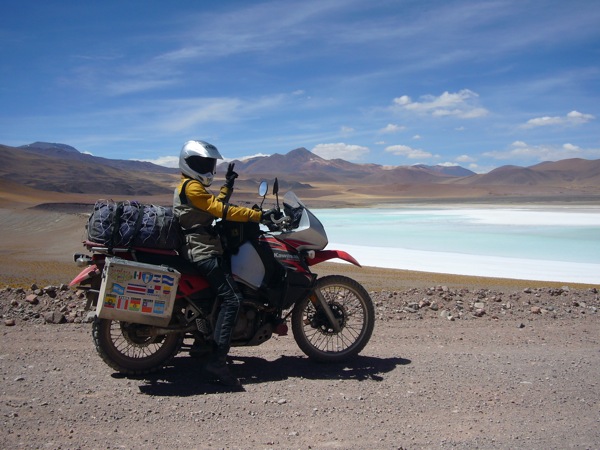
We reached the Argentinean border outpost and had to knock loudly on the door to stir the officials inside. I don’t think they were expecting anyone. The officials did the paperwork as if we’d awoken them from a peaceful slumber, every form being filled out languidly and without a care in the world.
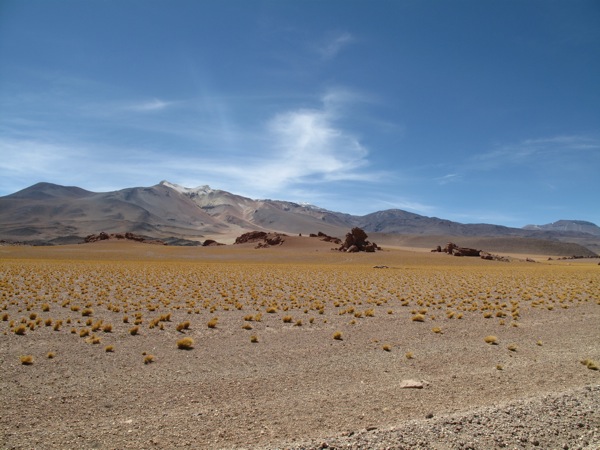
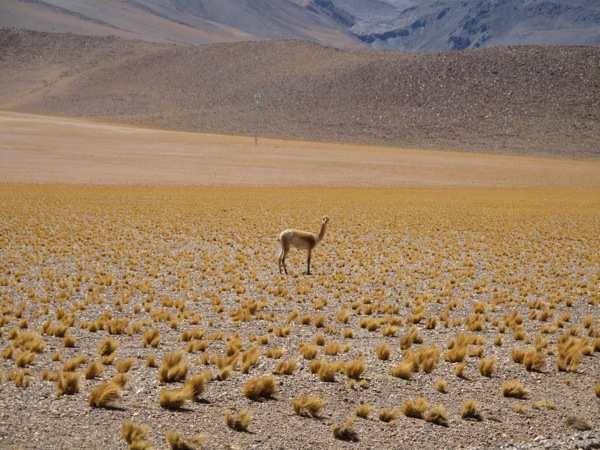
It was here that reality came crashing down on us. It was 6 pm by the time we had our entry stamps and papers. We had been foolish in leaving San Pedro de Atacama so late, blithely assuming the scale of the Chile/Argentina maps was similar to our Bolivia map. Bolivia is a small country, and Chile and Argentina are not. We’d ridden about an inch on the map today, which would have been only a few hours in Bolivia.
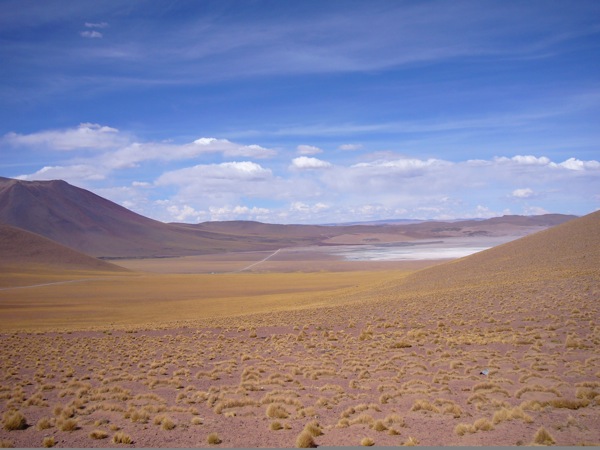
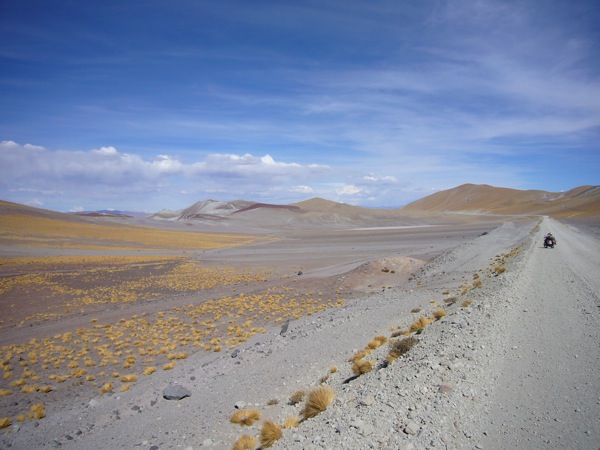
This revelation, piled on top of the struggles of the previous days and our state of exhaustion, was too much for Inna to bear. Upon realizing that it was already 6 pm and we had another 120 dirt road kilometers to go to the next town, she burst into tears. I felt terrible and tried to comfort her, noting that we still had hours of daylight left and that the road hadn’t been too bad so far. I did my best to take care of her and make her smile. The border guards took pity on us and told us they had bedrooms available if we wanted to stay the night, but tears aside, Inna was determined to press on.
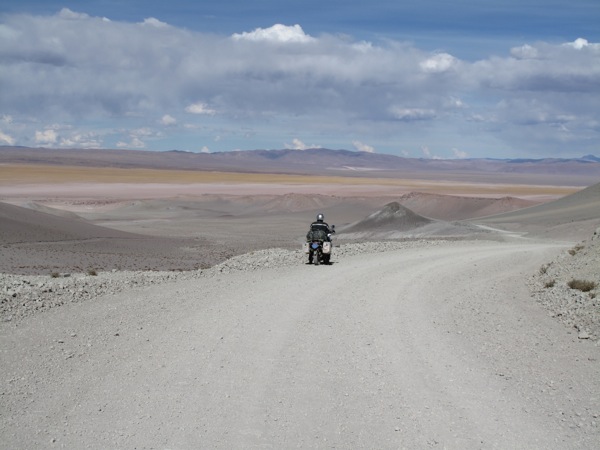
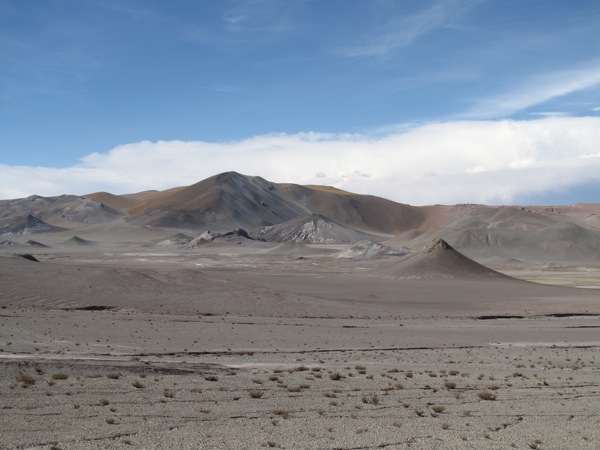
Unfortunately for us, the Chilean border guard was dead on and the Argentinean road was crappy from the very beginning. It was extremely corrugated, the vibration jarring us and aggravating our nerves even further. The sections of corrugation was broken up by our favorite surface, sand. Progress was slow but we were stubbornly grinding over the corrugation. Note that there are absolutely no photographs of the Argentinean side as we weren’t stopping for anything.
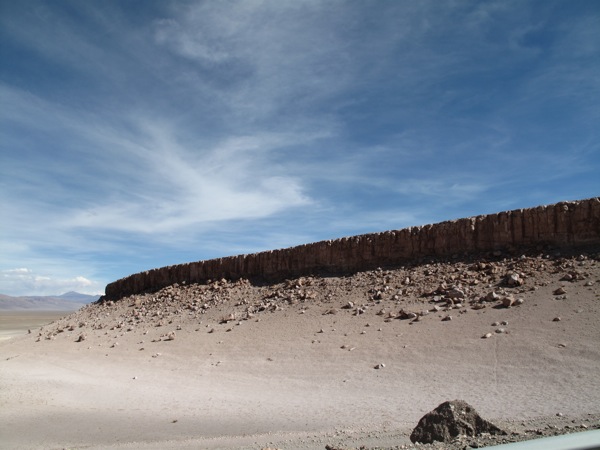
We finally reached the halfway point of the Argentinean road in a town called Olacapato. It looked like a reasonably sized town on the map, and we were hoping to get some gas. The map was deceiving and the town was just a few deserted streets. It was eery to ride through and we finally encountered a woman watching us from a doorway. I asked if the town had gas or a hotel, and she pointed us down the street.
We rode into the courtyard of the building indicated and talked to the lady proprietor. She said she had no gas, but had rooms. I looked at the room and it was surprisingly nice considering our surroundings. We were relieved to be done with the day and then the question of payment came up. We had no Argentinean pesos, only Chilean and American. There was no ATM to be found, let alone even a store. The lady wasn’t interested in taking foreign currency, so we were back on the bikes.
The sun was setting as we rode back to the center of town. The power station, a large diesel generator, was located in the center. The solitary engineer in his hard hat inside came out to investigate the two strange motorcycles parked out front. He was a friendly young man and I explained our situation. He said he had a few liters of “nafta” he could spare, if our bikes could run on it.
I had no clue what “nafta” was, other than a treaty, but he assured me it was “super” and he ran his little bike on it. I was a little leery, but when he brought the bright blue liquid out in a 3 liter Coca-Cola bottle, it smelled like gas. Our bikes were questionably low, so I decided to go for it and talked him into giving us an additional 4 liters. I would later discover that in Argentina they call gasoline “nafta”. Why they don’t call it “gasolina” like every single other Latin American country is beyond me and this conversation was a real waste of time. I’m also not sure why if he knew it was super grade gasoline he raised doubts about our bikes being able to run on it. Annoying but he did hook us up.
We couldn’t pay him of course, so a long conversation ensued about how to make good, with us finally agreeing he would meet us in the hotel we hoped to stay in San Antonio de Cobres at midnight after he got off work. He commuted home to there every night. We asked him how long it would take and he said 1.5 to hours.
The sun had set by the time we were back on the road, and a fantastic lightning storm was brewing over the mountain above the town. I was no longer feeling my exhaustion and was actually almost cheerful. Inna’s despair had left me with no room for any negative feelings as I needed to keep her spirits up and get us to a hotel for the night. I had done everything that could be done in our current situation, so there was nothing left for me to worry about besides Inna.
The lightning storm was dramatically beautiful. As we rode along with only half of our headlights, highbeams only, the flashes of lightning would light up the entire valley. The small cones of light in front of us would momentarily disappear in an instant of near full daylight. The Wanderlust GPS maps I had downloaded in Peru worked well in Argentina, unlike Bolivia, so I had a good sense of the turns I couldn’t see on the road ahead and I could see us make measureable progress.
I tried to encourage Inna a bit, but she wasn’t answering her starcom. I stopped to talk to her and she was in tears. She was so tired that she vented her frustration in tears, looking for me to comfort her and make her feel better. I felt so terrible for allowing us to get into this situation, and I told her what a strong woman she was and how proud of her I was, trying to buoy her spirits. We normally ride with dark tinted shields, but in the dark we were riding with them flipped up. She was riding behind me, so was getting a fair share of dust. As we talked in the darkness I changed her helmet to a clear shield, hoping the additional comfort would make the next 50 km a little easier on her.
We continued our late night ride, and mercifully the road was better since Olacapato than it had been before it. We wound through several valleys and I was hyper alert and relatively cheerful. I encouraged Inna over the radio, telling her how close we were to San Antonio. We were treated to an encounter with the bright reflecting eyes of a curious fox in the road ahead of us.
When we were 15 km from town, I relayed the good news to Inna, and then the lightning storm I had been enjoying thus far decided we’d enjoyed it enough, and the rain began to pour down upon us. We had put our top rain liners in for warmth before leaving [O], but our legs were not protected. The rain poured and poured, with occasional disturbingly close lightning strikes as we reached the edge of town.
We found the hotel around 11 pm, surprisingly nice given the shabbiness of the town. I hurried Inna into the lobby, telling to leave all of the unpacking of the bikes to me. We had a confusing discussion with the receptionist about the price since our brains were addled and the Argentines used the same dollar symbol ($) as the US dollar, but we finally realized the room would not cost $185 US for the night and I sent Inna to the room for a hot shower.
When I went back outside to unpack the bikes and move them to sheltered parking, not a drop of rain was falling. Irritatingly cruel. When I came back into the lobby, I met an Italian rider named Stefano, who was on a several month long tour of Chile and Argentina. We chatted for a bit, and I said I’d share a tea with him if he was still up when I got back from running into town to find an ATM and get us some snacks and water, as we had skipped both lunch and dinner.
The town was up late and the main street was closed. It was still Carnival and the youth were dressed in wild costumes parading down the street in front of stands. I got some cash and bought some snacks, enjoying the circus atmosphere a bit before going back to the hotel. Stefano had already gone to bed, and I found Inna, much happier and relaxed after a hot shower. We had a snack and some tea and bread from room service. I cleaned myself up and were soon happily asleep, grateful for the happy ending to a trying day. The guy whose name I never learned showed up around midnight, and I was out of bed, paid him, and was back asleep in the blink of an eye.
